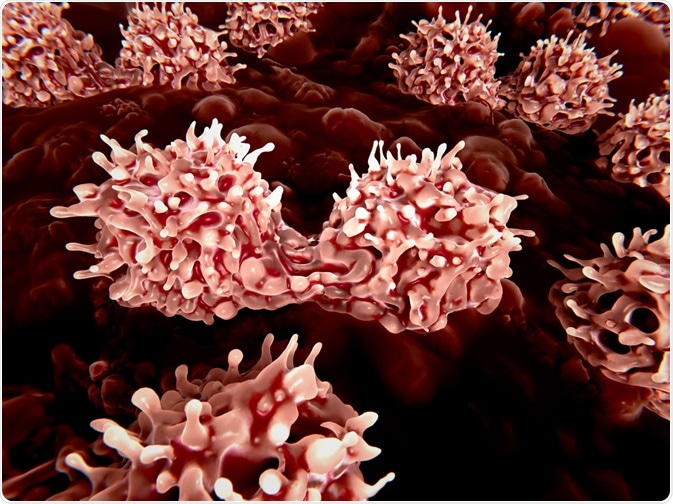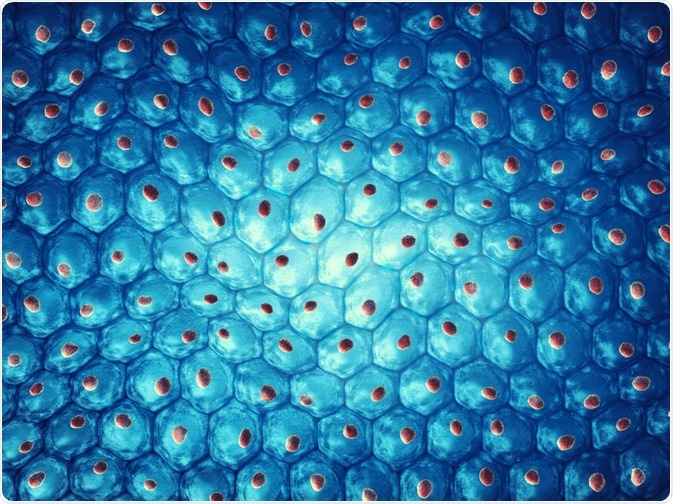Overview of induced pluripotent stem cells
Induced pluripotent stem cells (iPSCs) are a type of pluripotent stem cells that are directly generated from somatic cells such as skin or blood cells.

Image Credit: Juan Gaertner/Shutterstock.com
The iPSCs can exhibit functional similarities to embryonic stem cells, which is beneficial to research. It is expected that iPSCs will facilitate the development of an unlimited source of any kind of human cell required for therapeutic and research purposes.
In 2012, Sir John B. Gurdon and Shinya Yamanaka were awarded the Nobel Prize in Physiology or Medicine for the breakthrough discovery that somatic cells can be reprogrammed to pluripotent stem cells.
There are broadly three categories of cell potency: totipotent, pluripotent, and multipotent. Zygotes and blastomeres are termed “totipotent” as they give rise to all embryonic and extraembryonic tissues.
Pluripotency describes the potential of stem cells to differentiate into three primary germ cell layers, but not extra-embryonic tissues such as the placenta. The three primary germ cell layers include endoderm (interior stomach lining, gastrointestinal tract, the lungs), mesoderm (muscle, bone, blood, urogenital), and ectoderm (epidermal tissues and nervous system).
Cells in developed tissues are termed either “multipotent” or “unipotent” because they can only differentiate into a limited number of cell types in a specific lineage. Upon terminal differentiation, cells completely lose their developmental potential.
During human embryonic development, somatic cells arise from a common stem cell, which differentiates via a set of cell and molecular changes triggered by specific gene expression patterns.
The iPSCs technology is based on utilizing the differentiation process in reverse by reprogramming mature cells to become pluripotent stem cells, by inducing expression of specific genes encoding embryonic transcription factors.
Scientists can use iPSCs to differentiate into cell types required for therapeutic purposes.
Generation and challenges of induced pluripotent stem cells
It is challenging to isolate, culture, purify, and differentiate stem cell lines from embryonic tissues. As a result, scientists have to explore other options such as creating pluripotent cells using existing non-pluripotent cells.

Image Credit: Nobeastsofierce/Shutterstock.com
Nuclear reprogramming is one technique to achieve pluripotency. A stable change in the nucleus of a mature cell is deliberately induced; it can be maintained and replicated as the cell divides through mitosis.
Reacquisition of a pluripotent state can be observed with these changes, resulting in developmental potential. Historically, nuclear reprogramming has been performed using somatic cell nuclear transfer (SCNT) and altered nuclear transfer (ANT).
In the pioneering 2006 study, Takahashi and Yamanaka at Kyoto University in Japan reported the introduction of four specific genes (named Myc, Oct3/4, Sox2, and Klf4) encoding embryonic transcription factors can reprogram mouse fibroblasts to pluripotent stem cells.
In 2007, there were further breakthroughs by deriving iPSCs from human cells, using either the original four genes (Myc, Oct3/4, Sox2, and Klf4) or a different combination containing Oct4, Sox2, Nanog, and Lin28.
The previous methods suffered from low efficiency, yielding iPSCs in less than 1% of the starting adult cells.
In the earliest studies, the retroviruses which were used to deliver the four transcription factors could potentially cause mutagenesis. The gene c-Myc, one of the four transcription factors used in the first pioneering 2006 study, is known to induce tumor growth in some cases. Therefore, scientists attempted to improve reprogramming efficiency and decrease mutagenesis.
In theory, it is possible to biopsy from an accessible cell type from a patient and reprograms to the required cell type. However, reprogramming is not simply done by adding transcription factors to a population of differentiated cells.
Scientists investigated the introduction of three factors that use the orphan nuclear receptor Esrrb with Oct4 and Sox2. They found that they were able to convert mouse embryonic fibroblasts to iPSCs, confirming that c-Myc is dispensable for direct reprogramming.
The iPSCs generated using retroviral vectors used reverse transcriptase to produce DNA from their RNA genome, then incorporate DNA into the host's genome. However, this process cannot be fully controlled, leading to unpredictable effects.
Other integrating viruses such as lentiviruses can raise the efficiency of reprogramming but the expression of viral transgenes remains a critical issue.
Techniques such as introducing combinations of factors in a single viral "cassette" into a known genetic location will enable scientists to trigger programming more safely, thereby moving iPSC technology a step closer to clinical application.
It is expected that iPSCs technology will serve as the basis for autologous cell replacement therapy.
The main advantage of this technology is the reduced possibility of immune rejection as the cells originate from the patient therefore, the need for immunosuppressive drugs following cell transplantation would be reduced, or eliminated.
Ongoing research is focusing on differentiating iPSCs into a specified cell lineage that will support treatment or tissue regeneration.
In 2008, Dimos and colleagues showed that induced pluripotent stem cells generated from patients with Amyotrophic lateral sclerosis (ALS) can be differentiated into motor neurons, which are the cells that are damaged by ALS.
Other research groups generated cardiomyocytes from iPSCs, which originated from human and murine fibroblasts. However, compared to that seen with cardiomyocytes derived from embryonic stem cells (ESC) or fetal tissue, the maturation process into cardiomyocytes generated from iPSCs is impaired.
The expression of genetic markers in the iPSC-derived cardiac cells showed some variations compared to that seen in ESC-derived cardiomyocytes therefore, it is currently too early for iPSCs to be used to generate cardiomyocytes for clinical application.
Although extensive basic research is still needed before iPSCs can be clinically applied, these cells are considered to be the future therapy for many diseases.
References
- Brambrink, T., Foreman, R., Welstead, G. G., Lengner, C. J., Wernig, M., Suh, H., & Jaenisch, R. (2008). Sequential expression of pluripotency markers during direct reprogramming of mouse somatic cells. Cell stem cell, 2(2), 151-159.
- Dimos, J. T., Rodolfa, K. T., Niakan, K. K., Weisenthal, L. M., Mitsumoto, H., Chung, W., ... & Wichterle, H. (2008). Induced pluripotent stem cells generated from patients with ALS can be differentiated into motor neurons. science, 321(5893), 1218-1221.
- Feng, B., Jiang, J., Kraus, P., Ng, J. H., Heng, J. C. D., Chan, Y. S., ... & Vega, V. B. (2009). Reprogramming of fibroblasts into induced pluripotent stem cells with orphan nuclear receptor Esrrb. Nature cell biology, 11(2), 197-203.
- Haase, A., Olmer, R., Schwanke, K., Wunderlich, S., Merkert, S., Hess, C., ... & Maier, L. S. (2009). Generation of induced pluripotent stem cells from human cord blood. Cell stem cell, 5(4), 434-441.
- Pfannkuche, K., Liang, H., Hannes, T., Xi, J., Fatima, A., Nguemo, F., ... & Halbach, M. (2009). Cardiac myocytes derived from murine reprogrammed fibroblasts: intact hormonal regulation, cardiac ion channel expression, and development of contractility. Cellular Physiology and Biochemistry, 24(1-2), 73-86.
- Selvaraj, V., Plane, J. M., Williams, A. J., & Deng, W. (2010). Switching cell fate: the remarkable rise of induced pluripotent stem cells and lineage reprogramming technologies. Trends in Biotechnology, 28(4), 214-223.
- Sommer, C. A., Stadtfeld, M., Murphy, G. J., Hochedlinger, K., Kotton, D. N., & Mostoslavsky, G. (2009). Induced pluripotent stem cell generation using a single lentiviral stem cell cassette. Stem cells, 27(3), 543-549.
- Stadtfeld, M., & Hochedlinger, K. (2009). Without a trace? PiggyBac-ing toward pluripotency. nature methods, 6(5), 329.
- Stadtfeld, M., & Hochedlinger, K. (2010). Induced pluripotency: history, mechanisms, and applications. Genes & development, 24(20), 2239-2263.
- Stadtfeld, M., Maherali, N., Breault, D. T., & Hochedlinger, K. (2008). Defining molecular cornerstones during fibroblast to iPS cell reprogramming in mouse. Cell stem cell, 2(3), 230-240.
- Takahashi, K., & Yamanaka, S. (2006). Induction of pluripotent stem cells from mouse embryonic and adult fibroblast cultures by defined factors. cell, 126(4), 663-676.
- Takahashi, K., & Yamanaka, S. (2006). Induction of pluripotent stem cells from mouse embryonic and adult fibroblast cultures by defined factors. cell, 126(4), 663-676.
- Takahashi, K., Tanabe, K., Ohnuki, M., Narita, M., Ichisaka, T., Tomoda, K., & Yamanaka, S. (2007). Induction of pluripotent stem cells from adult human fibroblasts by defined factors. cell, 131(5), 861-872.
- Yee, J. (2010). Turning somatic cells into pluripotent stem cells. Nature Education, 3(9), 25.
- Yu, J., Vodyanik, M. A., Smuga-Otto, K., Antosiewicz-Bourget, J., Frane, J. L., Tian, S., ... & Slukvin, I. I. (2007). Induced pluripotent stem cell lines derived from human somatic cells. science, 318(5858), 1917-1920.
- Yu, J., Vodyanik, M. A., Smuga-Otto, K., Antosiewicz-Bourget, J., Frane, J. L., Tian, S., ... & Slukvin, I. I. (2007). Induced pluripotent stem cell lines derived from human somatic cells. science, 318(5858), 1917-1920.
- Zhang, J., Wilson, G. F., Soerens, A. G., Koonce, C. H., Yu, J., Palecek, S. P., ... & Kamp, T. J. (2009). Functional cardiomyocytes derived from human induced pluripotent stem cells. Circulation Research, 104(4), e30-e41.
Last Updated: Feb 18, 2020